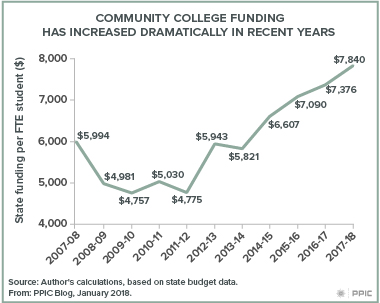Nearly 70% of new funding for higher education—or $570 million—in Governor Brown’s proposed budget goes to the state’s community colleges. This continues a trend that has seen community colleges get an ever-growing portion of higher education funding even as overall funds for higher education have shrunk—from 18% of the General Fund 40 years ago to just under 12% now. This trend is likely to continue—mostly because Proposition 98, passed by the voters in 1988, sets minimum funding levels for the state’s K–12 and community college systems.
 These mandated minimum funding levels have protected community colleges from the kind of budget cuts that have affected California’s other public higher education institutions. In addition, Governor Brown has prioritized investments in the community college system, which serves 2.1 million students and is the gateway to higher education for the vast majority of California students.
These mandated minimum funding levels have protected community colleges from the kind of budget cuts that have affected California’s other public higher education institutions. In addition, Governor Brown has prioritized investments in the community college system, which serves 2.1 million students and is the gateway to higher education for the vast majority of California students.
Governor Brown and the legislature have vastly increased investment in community college programs intended to improve student outcomes and eliminate achievement gaps, including programs focused on adult education and career technical education. Moreover, last year the governor provided a one-time allocation of $150 million to develop the Guided Pathways program, aimed at integrating disparate student success programs into one model and creating clear pathways for students to earn a certificate or degree, or transfer to a four-year college.
The governor’s current budget proposal also contains a new funding formula for the community colleges. This formula would shift future funding to districts with higher proportions of low-income students and those that have achieved better student outcomes. Under this formula, each district would get 50% of its funding based on enrollment, 25% based on enrollment of low-income students—those who receive a tuition waiver or Pell grant—and 25% based on district performance. Performance would be measured by the number of degrees and certificates provided, the number of students who complete a degree or certificate in three years or less, and the number of Associate Degrees for Transfer granted.
California’s community colleges have long struggled with low completion rates, low transfer rates, and persistent achievement gaps. Additional funds and a new funding formula may help to address these issues and lead to greater student success—which, for most community college students, means transferring to a four-year institution. Today, more than half of CSU students are community college transfers, as are nearly one-third of UC students. If current investments in community colleges do in fact improve student outcomes, then California’s four-year institutions will need to be ready for even more transfers.
Read the report Higher Education in California: Investing in Public Higher Education
Visit the PPIC Higher Education Center


